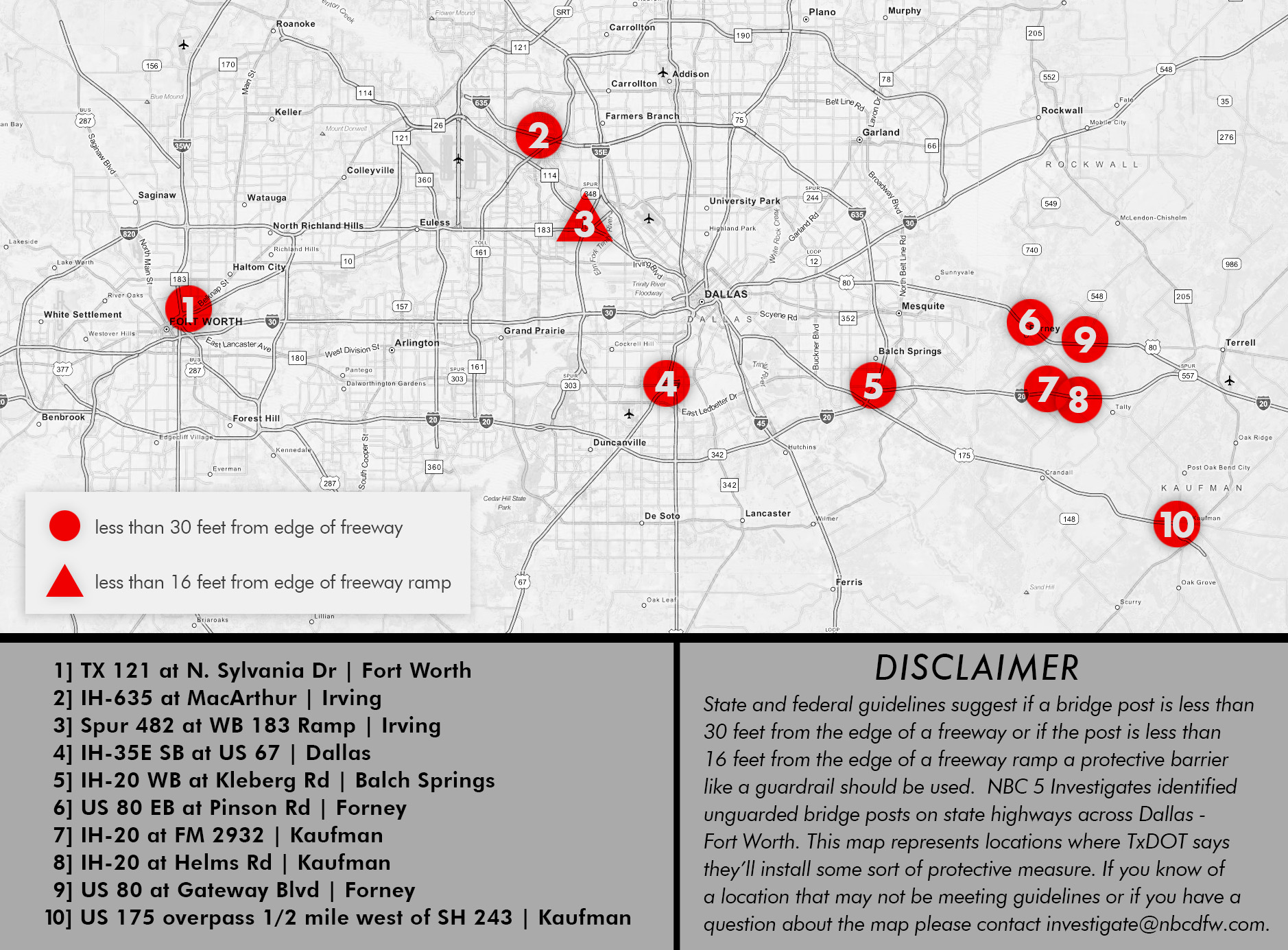An NBC 5 investigation discovered the Texas Department of Transportation is failing to protect drivers from some concrete bridge posts that sit close to the edge of freeways, presenting a hazard.
Deaths have occurred at some locations where state and federal guidelines suggest protective barriers should have been installed.
After NBC 5’s investigation, TxDOT agreed to install barriers in at least five freeway locations identified by the NBC 5 Investigates team.
Across the Dallas-Fort Worth area, NBC 5 Investigates found places where giant concrete bridge support posts sit out in the open, unprotected, even though state and federal guidelines suggest guardrails could help reduce the risk of a death in a crash.
There are many reasons why drivers may run off the road. It could be wet pavement, a distraction in the car, even a drunken or drowsy driver. But some families and safety advocates question if TxDOT has made some run-off-road crashes worse by failing to install guardrails that could have prevented people from slamming into concrete pillars.
Ron Roberts’ brother-in-law Toby Tappen died in 2013 after hitting a bridge post on Spur 482 under Texas Highway 183 in Irving near the former site of Texas Stadium.
“It’s just one of the saddest things I’ve ever had to go through,” said Roberts.
Local
The latest news from around North Texas.
Investigators said Tappen had a medical problem, possibly a heart attack behind the wheel, and ran off the road.
The medical examiner determined it was the impact from the bridge post that killed him.
“I believe that as strong as Toby was, that had the impact not killed him, I believe he might have had a chance to survive,” said Roberts.
TxDOT’s safety guidelines suggest protective barriers like guardrails if a bridge post sits less than 30 feet from the edge of a freeway, or if the post is less than 16 feet from the edge of a freeway ramp.
But on the freeway ramp where Tappen died, the post is only about five feet from the road and there was no guardrail.
Roberts said that leaves no margin for error.
“I mean, a blowout, anything could cause a car to swerve and hit that,” he said.
Tappen was not the first person to die at the Spur 482 location. In fact, photos of his crash show crosses on the side of the road from another fatal crash in the same spot. In Irving, police records show at least five people have died hitting the same bridge posts at Spur 482.
In 1991 a Navy petty officer from Alabama died after colliding with those posts. A police report said he was driving too fast on a wet road.
In 2002, 2006 and 2007 three crashes killed two drunken drivers and a passenger in one of the vehicles. Then in 2013, Toby Tappen’s crash, which was caused by a medical emergency.
“I don’t think it would take a whole lot to put something there. You put some kind of guardrail or some kind of barrier,” said Roberts.
Protective barriers like guardrails are designed to flex, catching cars and re-directing them into the roadway. In many cases that can protect the occupants of the vehicle from more serious injuries
So why didn’t the state install barriers on Spur 482 where concrete bridge posts sit just feet from the edge of the freeway?
NBC 5 Investigates interviewed TxDOT Director of Operations, Randy Hopmann. When asked if people are dying in crashes why wouldn’t TxDOT protect a location, Hopmann responded, “It depends on the cause of the crash. There’s variables in each of these things.”
Hopmann said the driver’s actions often contribute to the crash.
In an email to NBC 5, TxDOT even suggested Toby Tappen was partly to blame because he was driving without a valid driver’s license.
But TxDOT still agreed it would go back and look at the bridge posts on Spur 482.
“If we believe there is something TxDOT could do to prevent further crashes from occurring in a particular location we will take corrective action necessary,” said Hopmann.
Just three days after NBC 5 Investigates interviewed Hopmann, TxDOT agreed the Spur 482 location should have a barrier. TxDOT has installed a temporary barrier there because the bridge is slated for construction.
That location is not the only one where NBC 5 Investigates found unprotected bridge posts too close to the road.
NBC 5 Investigates drove some of the busiest freeways in Dallas and Tarrant counties, identifying and measuring unprotected bridge posts.

On State Highway 121 at Sylvania near downtown Fort Worth, unprotected bridge posts measure about 15 feet from the side of the road.
Remember, on the main lanes of a freeway, barriers are recommended if the post is less than 30 feet.
Other bridge posts came up short as well.
NBC 5 Investigates spotted other locations on Interstate 20 and Helms Trail in Forney, along Interstate 20 and Kleburg Road in Balch Springs and on Interstate 35 at US Highway 67 in Dallas.
After NBC 5 Investigates measured, TxDOT agreed all of those locations should have barriers.
“That’s something TxDOT needs to catch without you or I having to run around with tape measures,” said former administrator with the United States Department of Transportation, Brigham McCown. He now runs a nonprofit transportation safety group.
McCown’s concerned TxDOT’s own engineers didn’t catch these problems.
“Because these things shouldn’t be missed, they should be caught right away,” said McCown.
NBC 5 was not the first to notify TxDOT of unprotected bridge posts in recent months.
“I couldn’t believe how many unguarded bridge columns there were,” said Mark Boswell, whose nephew, Collin Boswell, died in a crash in December.
On US Highway 80 and at Pinson Road in Forney, Collin Boswell hit an unguarded bridge post that was just 27 feet from the edge of the road.
Boswell is convinced a guardrail would have made a difference in his nephew’s crash.
“He had a small car, a light car, it would have bounced off the rail,” said Boswell.
Police initially found the crash was caused by a rain-soaked road, but months later the medical examiner also determined Collin’s blood alcohol level was above the legal limit.
“If Collin was responsible for the accident, I don’t believe he was responsible for the death,” said Collin’s father, Philip Boswell.
After Collin’s dad and uncle questioned why there was no guardrail, TxDOT agreed a guardrail should be installed.
“I can’t really speculate on why it was not installed originally, but I’m happy to report that our Dallas District did go out and look at the site and they took corrective action promptly,” said Hopmann.
The Boswell family has since discovered other locations with unprotected posts and TxDOT agreed to install guardrails at six of them.
TxDOT has already put up a rail at Interstate 635 and MacArthur Boulevard in Irving after the Boswell’s raised concerns.
“It’s showing a significant problem and they need to deal with it now,” said Philip Boswell.
Hopmann said he couldn’t speculate on why guardrails weren’t installed originally during construction at US 80 and Pinson Road.
“I cannot say it was a mistake. There’s engineering judgment call on every location,” said Hopmann.
Hopmann said the guidelines are not hard and fast rules and, engineers sometimes have different opinions of whether guardrails will help or not at a particular location.
In fact, NBC 5 Investigates found at least four more spots where unguarded posts are less than 30 feet from the edge of the road but TxDOT still said barriers are not needed, including one location on the westbound side of Interstate 30 at US 80, which measured about 23 feet.
TxDOT said it constantly re-evaluate locations, studies new crash reports and drives the freeways looking for areas that would benefit from additional safety measures.
“If something needs to be done, if a change needs to take place, then we take appropriate action,” said Hopmann.
But what’s not clear is why TxDOT did not take action in places like that bridge on Spur 482 until NBC 5 Investigates pointed them out.
“Hopefully TxDOT is going back and looking at their procedures right now to figure out how these things could get missed,” said McCown.
Some families now wonder how many more unprotected bridge posts are out there across the state.
“We hope that by drawing attention to the problem that something can be done,” said Roberts.
If you see a location anywhere in the state where an unprotected post appears to close the road, send in the location to investigate@nbcdfw.com and NBC 5 Investigates will take a look.



